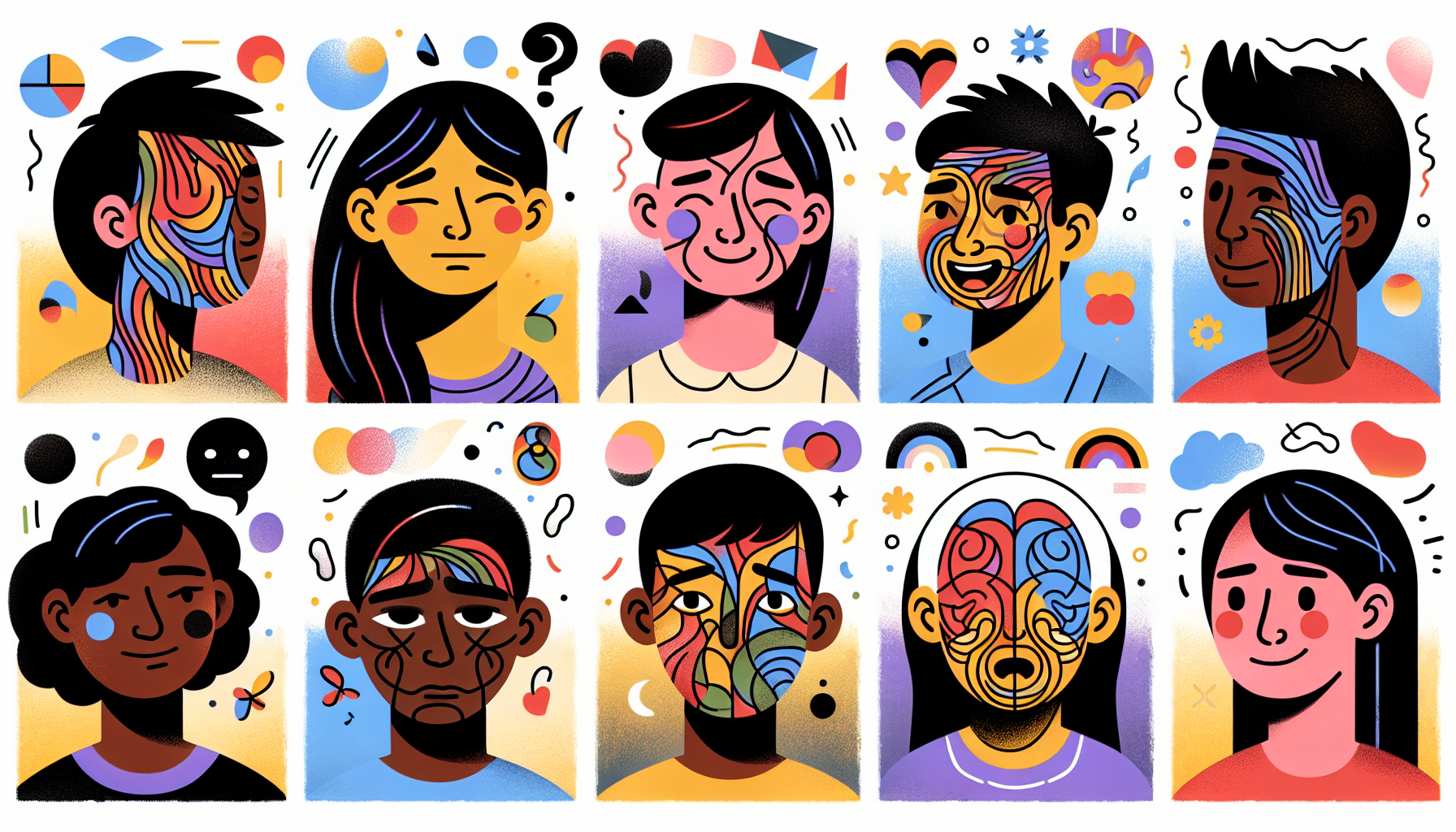Understanding Emotions in Autism
Autism is a neurodevelopmental disorder that affects how individuals perceive and process information, including emotions. Autistic individuals often experience emotions differently from neurotypical individuals. Their emotional experience may be more focused on “very grand emotions” such as justice, mercy, fairness, longsuffering, passion, and truth, rather than secondary emotions like sadness, joy, jealousy, and fear [1].

Emotional Experience in Autism
Autistic individuals can have a unique emotional experience that differs from the typical emotional range. They may have intense emotional reactions to specific situations or stimuli. Their emotional landscape may be characterized by strong convictions and a focus on principles of justice and fairness. Autistic individuals often form deep connections with others who share similar emotional experiences and a sense of solidarity. Their communication style is often direct and blunt, which can be perceived as offensive or insensitive by neurotypicals.
Challenges in Emotional Cues
One of the challenges faced by autistic individuals is understanding and responding to emotional cues from neurotypical individuals. Autistics may have difficulty interpreting facial expressions, body language, and tone of voice, which are commonly used to convey emotions. This can lead to misunderstandings, social conflicts, and difficulties in building emotional connections. The differences in emotional cues and social norms between autistic and neurotypical individuals can contribute to a lack of understanding, misinterpretation, and feelings of isolation [1].
Recognizing and interpreting emotions accurately is a complex task, even for neurotypical individuals, and can be particularly challenging for autistic individuals. The ability to understand and interpret their own emotions accurately may also be hindered. This difficulty in emotional recognition and interpretation can impact their overall emotional well-being and social interactions [2].
While autistic individuals may face challenges in understanding emotional cues, it is important to note that they do not lack empathy. Autistic individuals can recognize feelings and demonstrate empathy, even in situations of intense emotional reactions. Empathy in autism is often based on shared experiences and emotions related to justice, fairness, and the greater good, rather than solely on trying to understand another person’s emotions.
Understanding the emotional experiences and challenges faced by autistic individuals is crucial for promoting empathy, communication, and building emotional connections. By recognizing and acknowledging these differences, we can work towards creating an inclusive and supportive environment for individuals with autism.
Empathy and Connection
When it comes to understanding emotions in autism, it’s important to recognize that autistic individuals may have unique experiences and expressions of empathy. Contrary to the stereotype that individuals with autism lack empathy, research suggests that they can indeed experience empathy and form deep connections based on shared emotional experiences and a sense of solidarity.
Unique Empathy in Autistics
Autistic individuals may have a different experience of empathy, which is based on their own neurology and understanding. Their empathy is not necessarily rooted in trying to understand another person’s emotions, but rather in sharing experiences and emotions related to justice, fairness, and the greater good. This unique form of empathy reflects their distinct way of perceiving and interpreting the world.
Building Emotional Connections
Building emotional connections with autistic individuals requires understanding and respecting their communication style. Autistic individuals often communicate in a direct and blunt manner, which can be perceived as offensive or insensitive by neurotypicals. It is important to recognize that this communication style is not intended to be hurtful but rather reflects their sincerity and authenticity.
To form meaningful emotional connections, it is essential to take the time to understand the codes and language of autistic individuals. This involves being patient and attentive to their unique ways of expressing emotions. By listening and observing carefully, one can better decipher their emotions and react appropriately.
By acknowledging and appreciating the distinct empathy and communication style of autistic individuals, we can foster understanding, acceptance, and meaningful connections. It is important to avoid generalizations and stereotypes, recognizing that each individual on the autism spectrum is unique in their emotional experiences and expressions. Through empathy and open-mindedness, we can bridge the gap and create a more inclusive and understanding society [3].
Therapeutic Interventions
When it comes to addressing the emotional challenges faced by individuals with autism, therapeutic interventions play a crucial role in providing support and promoting emotional well-being. Two effective therapeutic approaches commonly used are Cognitive Behavioral Therapy (CBT) and adaptations in therapy tailored for individuals with autism.
Cognitive Behavioral Therapy (CBT)
Psychological interventions informed by cognitive behavioral theory, such as Cognitive Behavioral Therapy (CBT), have shown efficacy in treating mild to moderate anxiety and depression in autistic children and adults. Autistic individuals often experience disproportionately high rates of co-occurring emotional problems, making CBT a valuable tool in addressing these issues [4].
CBT aims to identify and modify maladaptive thought patterns and behaviors that contribute to emotional distress. It helps individuals develop coping strategies, problem-solving skills, and a better understanding of their emotions. By challenging negative thoughts and replacing them with more positive and adaptive ones, CBT empowers autistic individuals to manage their emotions effectively.
Adaptations in Therapy
Therapists working with autistic clients often make adaptations to their practice to ensure the therapy is tailored to the unique needs of individuals on the autism spectrum. These adaptations address specific challenges faced by autistic individuals, such as rigidity in thinking and pacing sessions appropriately.
Some common adaptations made in therapy for autistic clients include:
- Structured and Concrete Approach: Autistic individuals often benefit from a structured and concrete approach to therapy. Providing clear instructions, breaking down complex concepts into simpler ones, and utilizing visual aids can enhance understanding and engagement.
- Behavioral Strategies: Incorporating behavioral strategies, such as reward systems and token economies, can help reinforce positive behaviors and motivate individuals during therapy sessions.
- Use of Plain Language: Using plain language and avoiding jargon or ambiguous terms ensures clear communication and comprehension.
- Discussion of Hobbies: Incorporating discussions about hobbies and special interests can facilitate rapport-building and engagement in therapy.
- Psychoeducation about Emotions: Providing psychoeducation about emotions, their expression, and regulation can enhance emotional awareness and understanding.
- Written and Visual Information: Utilizing written materials, visual schedules, and visual aids can support individuals with autism in processing and retaining information.
Therapists working with autistic clients may face challenges related to rigidity in thinking, pacing of therapy, completion of homework, communication issues, difficulty recognizing and understanding emotions, co-occurring problems, and sensory issues. However, with appropriate adaptations and specialized training, therapists can effectively navigate these challenges and provide valuable support.
By implementing CBT techniques and making adaptations to therapy, professionals can help autistic individuals develop essential emotional regulation skills, improve their overall well-being, and enhance their quality of life.
Alexithymia in Autism
Alexithymia is a term used to describe a difficulty in identifying, understanding, and expressing emotions. In the context of autism, alexithymia represents a specific subgroup of individuals with autism who may experience challenges in emotional awareness. The prevalence of alexithymia in the autism spectrum disorder (ASD) group is significantly higher compared to the neurotypical group, with a prevalence of 49.93% in ASD individuals compared to 4.89% in neurotypical individuals [5].
Understanding Alexithymia
Autistic individuals often experience heightened alexithymia compared to the general population. Research has shown that autistic individuals score significantly higher on all scores, including total and subscales, of the Toronto Alexithymia Scale (TAS) compared to neurotypical individuals [5]. The TAS-20, a widely used measure of alexithymia, has also been found to discriminate between autistic and neurotypical individuals, with autistic individuals scoring higher on the total and subscale scores [5].
Alexithymia can manifest in different ways in autistic individuals. They may struggle to identify and label their emotions accurately, have difficulty describing their feelings, or find it challenging to differentiate between physical sensations and emotions. These difficulties can make it challenging for autistic individuals to connect with others and understand their own emotional experiences.
Addressing Emotional Awareness
Given the unique needs of autistic individuals with both alexithymia and ASD, tailored interventions can be beneficial in addressing emotional awareness. These interventions may involve training in identifying and communicating feelings, teaching emotional vocabulary, and utilizing techniques such as mindfulness exercises. By providing specific strategies and support, autistic individuals can develop a better understanding of their emotions and learn effective ways to express and manage them.
Therapeutic approaches like cognitive-behavioral therapy (CBT) can also be adapted to address the challenges related to alexithymia in autism. CBT can help individuals recognize and regulate their emotions, develop coping mechanisms, and improve emotional understanding and expression.
By acknowledging and addressing alexithymia in autism, individuals on the spectrum can gain valuable tools and strategies to enhance their emotional awareness and overall well-being. It is important for caregivers, educators, and therapists to provide support and create a supportive environment that fosters emotional growth and understanding in autistic individuals.
Helping Autistic Individuals
Supporting individuals with autism in understanding and managing their emotions is essential for their overall well-being. Autistic children and teenagers may face challenges in recognizing and expressing their emotions, which can impact their social interactions and daily functioning. In this section, we will explore strategies to help autistic individuals recognize emotions and manage strong emotions.
Recognizing Emotions
Autistic children and teenagers may struggle with recognizing and understanding their own and others’ emotions, particularly when upset. They might find it challenging to interpret facial expressions, tone of voice, or body language, which are important cues for identifying emotions. In some cases, they might label all negative or unpleasant emotions as anger or physical sensations such as heat or breathlessness. Conversely, they may not recognize when they are excited or may describe difficult-to-express emotions as “being bored”.
To help autistic individuals in recognizing emotions, it can be beneficial to provide clear explanations and concrete examples. Breaking down emotions into simpler terms and using visual aids, such as emotion charts or social stories, can aid in comprehension. Utilizing strategies like comic strip conversations, where thoughts, feelings, and behaviors are represented in a sequential manner, can assist in linking emotions with thoughts and actions. By helping autistic individuals understand why they feel the way they do, they can gradually develop emotional awareness and acceptance.
Managing Strong Emotions
Autistic individuals may experience intense emotions, and it is important to provide them with effective strategies to manage these strong feelings. Here are some techniques that can be helpful:
- 5-step process to calm down: Teach the individual a structured approach to calming down, such as taking deep breaths, counting to 10, identifying a safe space, and engaging in self-soothing activities.
- Relaxation exercises: Encourage relaxation techniques like deep breathing exercises, progressive muscle relaxation, or visualization exercises to help regulate emotions and promote a sense of calm.
- Sensory stimulation: Provide sensory tools or fidget toys that can offer comfort and help redirect focus during moments of heightened emotions. These tools can include stress balls, textured objects, or noise-cancelling headphones, depending on the individual’s preferences.
- Take a break and change activities: Encourage the individual to take breaks when they feel overwhelmed, allowing them to step away from the situation and engage in calming activities or hobbies that they find enjoyable.
- Physical activities: Engage in physical activities like going for a walk, practicing yoga, or participating in sports. Physical exercise can help release built-up tension and improve mood.
It is important to tailor these strategies to suit the individual’s specific needs and preferences. The support of experienced professionals such as GPs, pediatricians, psychologists, and other health professionals can be invaluable in providing guidance and developing personalized interventions to help autistic individuals understand and manage their emotions effectively.
Music Therapy Benefits
In the realm of autism and emotions, music therapy has emerged as a beneficial and effective intervention. Music processing in individuals with Autism Spectrum Disorders (ASD) showcases unique characteristics, revealing a potential avenue for therapeutic exploration. Understanding the role of music therapy can shed light on its benefits for individuals on the autism spectrum.
Music Processing in Autism
Research suggests that individuals with ASD have superior abilities in musical pitch and discrimination, as well as an apparent preserved ability to understand the affective qualities of music despite difficulties in emotional communication and interpretation in other domains. Music processing recruits various regions of the brain, including the prefrontal cortex, premotor cortex, motor cortex, somatosensory cortex, temporal lobes, parietal cortex, occipital cortex, cerebellum, and limbic regions. The involvement of the limbic system, responsible for processing emotional stimuli, during the experience of both pleasant and unpleasant music, provides insight into the emotional impact of music on individuals with ASD [7].
Role of Music Therapy
Music therapy has been found to be beneficial for individuals with ASD, offering a range of positive effects. One of the primary advantages of music therapy is its ability to facilitate communication and support socio-emotional behaviors. Through engaging with music, individuals with ASD can develop and improve their social engagement and nonverbal communication abilities. Music therapy also provides a platform for individuals with ASD to express themselves and connect with others in a unique and meaningful way.
Music therapy can help individuals with ASD develop timing and motor skills, as music often incorporates rhythm and movement. Engaging in musical activities can enhance coordination and motor control, providing an avenue for individuals with ASD to practice and refine their motor abilities.
Moreover, music therapy has been shown to improve socio-emotional communication abilities in individuals with ASD. By using music as a medium, therapists can create a safe and supportive environment for individuals to explore and express their emotions. Music therapy sessions often involve activities such as improvisation, songwriting, and listening to or performing music, all of which encourage emotional expression and connection.
By leveraging the unique processing of music in individuals with ASD, music therapy offers a powerful tool for addressing emotional challenges and fostering emotional well-being. Through the use of music, individuals with ASD can engage in a therapeutic process that supports their emotional development, communication skills, and social interactions.
Understanding the benefits of music therapy in the context of autism and emotions provides valuable insights into the potential of this intervention. By harnessing the power of music, individuals with ASD can enhance their emotional awareness, expression, and connection with others, paving the way for improved well-being and quality of life.
References
- https://psychcentral.com/blog/aspie/2019/03/271
- https://www.dynseo.com/en/understanding-the-emotions-of-a-person-with-autism/
- https://www.scientificamerican.com/article/people-with-autism-can-read-emotions-feel-empathy1/
- https://www.ncbi.nlm.nih.gov/pmc/articles/PMC6150418/
- https://www.ncbi.nlm.nih.gov/pmc/articles/PMC6331035/
- https://raisingchildren.net.au/autism/development/social-emotional-development/recognising-understanding-emotions-autistic-children-teens
- https://www.ncbi.nlm.nih.gov/pmc/articles/PMC2997252/

 We've just released an article!
Check out our blog!
We've just released an article!
Check out our blog!



